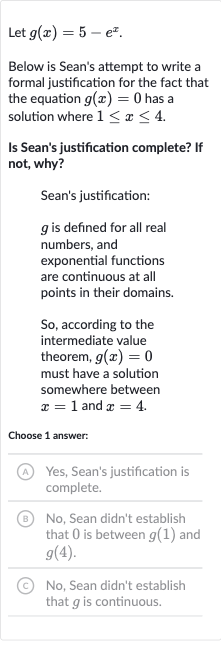AI tutor
Welcome to Bytelearn!
Let’s check out your problem:

Let .Below is Sean's attempt to write a formal justification for the fact that the equation has a solution where .Is Sean's justification complete? If not, why?Sean's justification: is defined for all real numbers, and exponential functions are continuous at all points in their domains.So, according to the intermediate value theorem, must have a solution somewhere between and .Choose answer:(A) Yes, Sean's justification is complete.(B) No, Sean didn't establish that is between and .(C) No, Sean didn't establish that is continuous.
Full solution
Q. Let .Below is Sean's attempt to write a formal justification for the fact that the equation has a solution where .Is Sean's justification complete? If not, why?Sean's justification: is defined for all real numbers, and exponential functions are continuous at all points in their domains.So, according to the intermediate value theorem, must have a solution somewhere between and .Choose answer:(A) Yes, Sean's justification is complete.(B) No, Sean didn't establish that is between and .(C) No, Sean didn't establish that is continuous.
- Evaluate : Let's first evaluate at and to determine the values of and .
- Check Straddling of : Now we need to check if and straddle , which means one should be positive and the other should be negative for the Intermediate Value Theorem to guarantee a solution for between and . Since is approximately , we can see that is positive because is greater than .
- Evaluate : Next, we need to evaluate whether g(4) < 0., and since is much larger than , will be negative.
- Apply Intermediate Value Theorem: Since is positive and is negative, and is continuous (as it is a combination of continuous functions: a constant, subtraction, and an exponential function), the Intermediate Value Theorem applies.
- Incomplete Justification: Sean's justification is incomplete because he did not explicitly establish that is greater than and is less than , which is necessary to apply the Intermediate Value Theorem to ensure that a zero of exists between and .
More problems from One-step inequalities: word problems
QuestionGet tutor help
QuestionGet tutor help
QuestionGet tutor help
QuestionGet tutor help
QuestionGet tutor help
QuestionGet tutor help
QuestionGet tutor help
QuestionGet tutor help
QuestionGet tutor help
